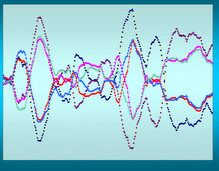It doesn't have to come back to the 4 - it can also go sideways into the 4. Occassionally it will go through the 4 and bounce off the EMA 8 - that is just as good. The example I'm showing here has an added feature which is the crossover - the crossover here is just icing on this cake and is not necessary for the set-up to work.
Here are three views on three different time frames of the same stock on Wednesday.
First the 30-minute chart annotated -

Next the 15-minute chart annotated -

And then the 10-minute chart annotated -

The point I was trying to make with the three views is that the 15 and 30 minute charts are easier to work with and - most importantly - the trade doesn't care what time frame you use - it breaks out when it breaks out. Sometimes you can catch a trade a few minutes earlier than other times and you might make or lose a few cents one way or another but most often it is better to just take the set-up when it is presented on the 15 or 30 minute charts and let the trade develop as it will.

1 comment:
Remarkable
Post a Comment